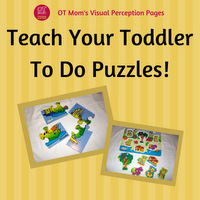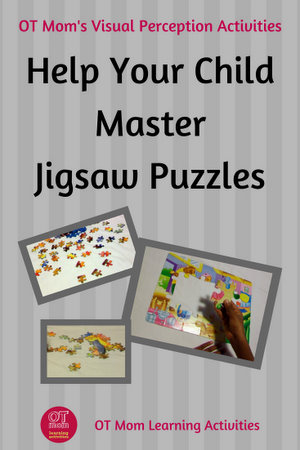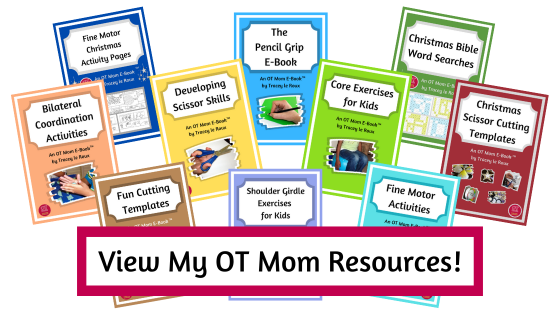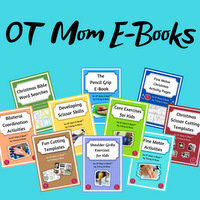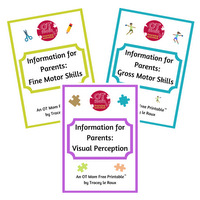- Home Page
- Visual Perception Activities
- Teaching Puzzles
Teaching Puzzles: A Parent's Guide For Kids Who "Can't Do" Puzzles
These tips for teaching puzzles are for any parent who has watched their child struggle with a jigsaw puzzle and give up.
This step-by-step guide will empower you with two simple methods to help your child master puzzles from 24 pieces and up. Help your child build skills and grow in confidence!
If your child has not yet mastered 4- and 8-piece puzzles, then take a look at my page for teaching puzzles to younger kids first.
I sometimes link to products (#Ad) that are similar to those I use and love. If you do purchase something through my links, I will receive a small commission that helps support my site - thank you!
Key Takeaways For Busy Parents:
- Start simple: Choose puzzles with uncluttered pictures. Turn all the pieces face up and look at the box cover together. Talk about what you see in the picture.
- Try the 'Edge" method: Find all the straight-edged pieces first. Use them to build the border of the puzzle first, then fill in the middle.
- Try the "Section" method:This works well for puzzles with distinct objects. Group pieces by color or object (eg all the red car pieces) and then build the puzzle one section/object at a time.
- Try and understand why your child is struggling: Perhaps your child may need to work on visual perception skills (eg visual discrimination), or perhaps their planning skills need some attention (knowing where to start).
- Getting started
- Method 1: Outside Edge First
- Method 2: Building in Sections
- Why A Child May Avoid Puzzles
- Helping Your Child Develop These Skills (and how to help older and younger kids)
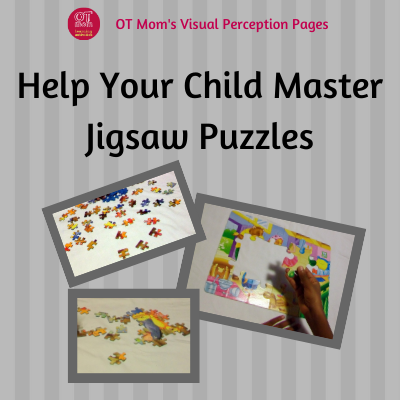
Getting Started With Teaching Puzzles
Here are some tips for getting started:
- Choose puzzles that have simple, uncluttered pictures.
Avoid puzzles that are too busy, or that have too many similar colored items.
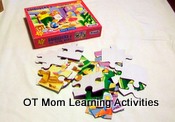
- Help your child turn over all the pieces and study the picture on the box.
- Talk together about what you see in the picture - not only does this help build vocabulary, but it helps your child learn to focus on the visual details.
Then you can choose one of these 2 methods:
I would say that neither way is “better” than the other, but if your child is used to doing the puzzle using one method, it would be good to challenge your child to do it “the other way” occasionally, in order to stretch and develop visual perceptual and planning skills.
Method 1: Outside Edge First
Step 1:
Sort out the puzzle pieces into those with straight edges and those without a straight edge.
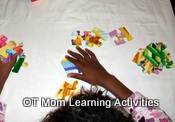 Find the edge pieces
Find the edge piecesStep 2:
Find the corners and place them correctly, using the picture on the box for reference.
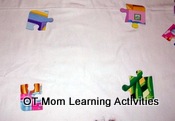 Place the corner pieces
Place the corner piecesStep 3:
Build the outside edge of the puzzle first, before the inside. Show your child how to look for pieces with similar colors to match them up.
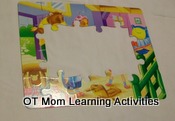 Build the outside edge
Build the outside edgeThis uses visual discrimination skills, as well as figure-ground perception (looking for a specific piece in a sea of pieces).
Method 2: Building in Sections
This method works well when the puzzle contains a number of clearly differentiated characters or objects.
You can sort out the pieces into different sections first (eg place all the red pieces together, all the grass pieces together), or look for one specific section as you go along, (eg look for all the pieces that make up the red car).
Step 1:
Group similarly colored pieces together and build one section at a time.
For example, in this Winnie-the-Pooh puzzle, the child found the Eeyore pieces and built Eeyore first.
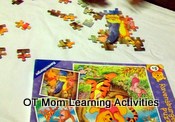 Find specific pieces and build the object
Find specific pieces and build the objectStep 2:
Now build the next section of the puzzle. For example, I pointed out the piece of Tigger behind Eeyore, so my child could find all the Tigger pieces and build Tigger, and so on.
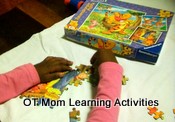 Now do the next object
Now do the next objectOnce different sections of the puzzle have been built, your child can fill in the gaps, including the outside edges.
Most children who are familiar with puzzles will use a combination of the two methods.
Use what works for your child to foster a sense of accomplishment! And most of all, have fun!
Why A Child May Avoid Puzzles
When a child avoids or "can’t do" jigsaw puzzles, there could be a
number of different reasons.
- poor visual discrimination skills – has not yet learned to pay attention to detail
- poor figure-ground perception – they can’t find the detail they are looking for in the sea of pieces
- poor visual closure skills – unable to see what piece would complete the piece of the puzzle they are looking at
- poor motor planning skills – the child simply does not know where to start. This child needs help to systematically work through the steps of doing a puzzle, as described on this page.
- lack of exposure to the concept of building puzzles (deprived backgrounds)
Helping Your Child
If you are in any way concerned about your child's abilities, please ask an occupational therapist for an evaluation. This website is not a substitute for occupational therapy! However, the tips below are designed to empower parents to help their kids be the best they can be!
- Choose good quality puzzles that can be used over and over again. Ravensburger puzzles#Ad are my favorite as each piece is unique and fits together perfectly. Why not swap puzzles with a friend every month?
- If your child is very young, or comes from a very deprived background, then visit my page of puzzle activities for toddlers first, and then come back here once your child has mastered up to 12 piece puzzles.
- If you have an older child or teenager who avoids doing puzzles, take a look at my tips and strategies for older kids over here.
 Doing puzzles with teens
Doing puzzles with teensTry some simple visual perception activities from the pages below, to build the visual perceptual skills needed for doing puzzles:
- visual discrimination tips - kindergarten
- figure-ground perception activities
- visual closure activities
Whether your child prefers the more structured method of buillding the edge first, or or the more focused way of building in sections, the key is to find what works for them.
The goal of teaching puzzles to your child is to build confidence and share a fun experience while boosting visual perception skills and problem-solving skils.
Sign up for my free, occasional newsletter to get a FREE Visual Perception Info Sheet, and to keep in touch with new pages and activities on my site!
- Home Page
- Visual Perception Activities
- Teaching Puzzles
Share this page to help others!
Didn't find what you were looking for? Try a search of my site!
